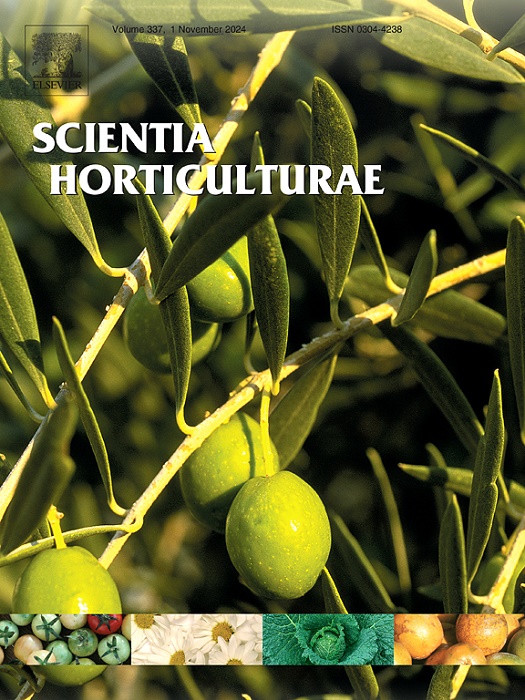Nano-encapsulated biostimulant enhances growth and postharvest quality of chili peppers (Capsicum annuum)
IF 3.9
2区 农林科学
Q1 HORTICULTURE
引用次数: 0
Abstract
Biostimulants play a vital role in improving the postharvest quality of agricultural produce. However, biostimulant efficiency assessment is mainly based on vegetative growth and crop yield. The function of biostimulants must be evaluated thoroughly to determine their contribution to enhancing the phenotypic characteristics and nutritional value of produce. This study evaluated a new formulation of microbial and botanical biostimulants on the capsaicin, ascorbic acid, flavonoid, and phenolic content of chilies. Biostimulant treatment recorded 0.618 quantum yield (QY) value compared with 0.581 quantum yield value of plants not treated with biostimulants, representing the plant's photosynthetic capacity. The chili plants treated with the biostimulant showed a significant increase in height and yield, which accounted for 60 cm of mean value and 575.41 g than plants that were not treated with the biostimulants, which represented 53 cm height of the mean value and 522.16 g of yield. Chili plants treated with biostimulant showed a higher L value, −15.38 ± 11.9 and a chroma value of 8.77 ± 5.56 in chili fruits compared to −8.29 ± 7.97 of l-value and 5.30 ± 6.81 mean chroma value in chili plants not treated with biostimulants. Red chilies harvested from plants that were not treated with biostimulants recorded the highest phenolic content (1.332 ± 0.56 mg/L) compared to the chilies that were treated with biostimulants (0.8830 ± 0.19 mg/L). In contrast, red chilies harvested from the plants treated with biostimulants recorded the highest flavonoid content (15.77 ± 1.0 mg/L) than plants not treated with biostimulants (13.098 ± 1.8 mg/L). Biostimulant treatment enhanced the capsaicin content in the early stages of chili development. The highest ascorbic acid content in chilies treated with biostimulants (144.29 ± 6.1 mg/L), followed by green chilies treated with biostimulants twenty-seven days after anthesis (132.85 ± 1.67). These results indicate the potential of nano-encapsulated microbial and botanical biostimulants to improve the postharvest quality of chili fruits.

纳米胶囊生物刺激素促进辣椒生长和采后品质
生物刺激素在提高农产品采后品质方面起着至关重要的作用。然而,生物刺激素的有效性评估主要基于营养生长和作物产量。必须对生物刺激剂的功能进行彻底的评估,以确定它们对提高农产品的表型特征和营养价值的贡献。本研究评价了一种新的微生物和植物生物刺激制剂对辣椒中辣椒素、抗坏血酸、类黄酮和酚类物质含量的影响。生物刺激剂处理的QY值为0.618,而未处理的QY值为0.581,代表了植物的光合能力。与未施用生物刺激剂的辣椒植株相比,施用生物刺激剂的辣椒植株的平均高度和产量分别增加了60 cm和575.41 g,平均高度增加了53 cm,产量增加了522.16 g。生物刺激素处理的辣椒果实的L值为- 15.38±11.9,平均色度为8.77±5.56,而未处理的辣椒果实的L值为- 8.29±7.97,平均色度为5.30±6.81。未经生物刺激剂处理的红辣椒的酚含量最高(1.332±0.56 mg/L),而未经生物刺激剂处理的红辣椒的酚含量为0.8830±0.19 mg/L。相比之下,经生物刺激素处理的红辣椒的类黄酮含量(15.77±1.0 mg/L)高于未经生物刺激素处理的(13.098±1.8 mg/L)。生物刺激素处理提高了辣椒发育早期辣椒素的含量。抗坏血酸含量最高的是生物刺激素处理辣椒(144.29±6.1 mg/L),其次是绿辣椒(132.85±1.67)。这些结果表明,纳米微囊化微生物和植物生物刺激素在改善辣椒果实采后品质方面具有潜力。
本文章由计算机程序翻译,如有差异,请以英文原文为准。
求助全文
约1分钟内获得全文
求助全文
来源期刊

Scientia Horticulturae
农林科学-园艺
CiteScore
8.60
自引率
4.70%
发文量
796
审稿时长
47 days
期刊介绍:
Scientia Horticulturae is an international journal publishing research related to horticultural crops. Articles in the journal deal with open or protected production of vegetables, fruits, edible fungi and ornamentals under temperate, subtropical and tropical conditions. Papers in related areas (biochemistry, micropropagation, soil science, plant breeding, plant physiology, phytopathology, etc.) are considered, if they contain information of direct significance to horticulture. Papers on the technical aspects of horticulture (engineering, crop processing, storage, transport etc.) are accepted for publication only if they relate directly to the living product. In the case of plantation crops, those yielding a product that may be used fresh (e.g. tropical vegetables, citrus, bananas, and other fruits) will be considered, while those papers describing the processing of the product (e.g. rubber, tobacco, and quinine) will not. The scope of the journal includes all horticultural crops but does not include speciality crops such as, medicinal crops or forestry crops, such as bamboo. Basic molecular studies without any direct application in horticulture will not be considered for this journal.
 求助内容:
求助内容: 应助结果提醒方式:
应助结果提醒方式:


